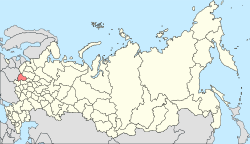Smolensk
| Smolensk (English) Смоленск (Russian) |
|
|---|---|
| - City - | |
 Smolensk railway station |
|
 Location of Smolensk Oblast in Russia |
|
|
|
|
|
|
|
|
|
|
| Administrative status (as of November 2011) | |
| Country | Russia |
| Federal subject | Smolensk Oblast |
| Administratively subordinated to | Smolensk Urban Okrug |
| Administrative center of | Smolensk Oblast,Smolensky District, Smolensk Urban Okrug |
| Municipal status (as of December 2011) | |
| Urban okrug | Smolensk Urban Okrug |
| Administrative center of | Smolensk Urban Okrug, Smolensky Municipal District |
| Head | Nikolay Alasheyev |
| Representative body | Smolensk City Council |
| Statistics | |
| Area | 166.35 km2 (64.23 sq mi) |
| Population (2010 Census) | 326,861 inhabitants |
| - Rank in 2010 | 54th |
| Density | 1,965/km2 (5,090/sq mi) |
| Time zone | MSK (UTC+03:00) |
| Founded | 863 |
| Postal code(s) | 214ХХХ |
| Dialing code(s) | +7 4812 |
|
|
|
| on | |
Smolensk (Russian: Смоленск; IPA: [smɐˈlʲensk]) is a city and the administrative center of Smolensk Oblast, Russia, located on the Dnieper River, 360 kilometers (220 mi) west-southwest of Moscow. Population: 326,861 (2010 Census);325,137 (2002 Census);341,483 (1989 Census).
The walled city in the center of Smolensk (along with the outskirts) was destroyed several times throughout its long history because it was on the invasion routes of both Napoleon and Hitler. Today, Smolensk is noted for electronics, textiles, food processing, and diamond faceting.
The name of the city is derived from the name of the Smolnya River. The origin of the river's name is less clear. One possibility is the old Slavic word "смоль" (smol) for black soil, which might have colored the waters of the Smolnya. An alternative origin could be the Russian word "смола" (smola), which means resin, tar, or pitch. Pine trees grow in the area, and the city was once a center of resin processing and trade. The Byzantine emperor Constantine VII (r. 913–959) recorded its name as "Μιλινισκα" (Miliniska).
...
Wikipedia



